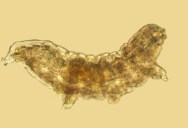What Is Likely To Be The Last Thing Alive On Earth? The Tardigrade.

Even if scientists don’t agree on exactly when the Earth will become uninhabitable for life, they do agree that it will happen.
As life disappears, what will be the last living thing standing?
It might surprise you to learn that it’s not cockroaches, scorpions, or humans that will make it until the very end, but a microscopic oddity known as the tardigrade.
There have been 5 major mass extinctions since life emerged 3.7 billion years, and they have wiped out at least 75% of species.
As hard as it is for life to emerge, it’s proven pretty tough to get rid of, and has bounced back every single time.

Even the Permian extinction event, which struck 250 million years ago and wiped out 90% of all species, couldn’t get rid of life for good.
If you’re curious, the Permian event was caused by a series of cataclysmic volcanic eruptions.
Some experts think we’re in the middle of a sixth mass extinction right now, primarily due to habitat destruction, pollution, climate change, and a whole host of other human-made problems. But as bad as this is likely to turn out for human beings, it’s unlikely to spell the end of all life on Earth.
Nuclear weapons are a bigger threat, as radioactive fallout would blanket a majority of globe. The resulting soot would spark a nuclear winter, causing the foundation of ecosystems to collapse by stopping photosynthesis and resulting in mass starvation.
That said, it’s likely that life in at least a part of the planet would survive – hardy invertebrates like cockroaches and scorpions, as well as microscopic life.
We could experience devastating astrophysical events, as well, like gamma-ray bursts, large asteroid impacts, or a supernova explosion. These could potentially sterilize life across the globe.

A supernova, for example, would shower Earth with intense cosmic radiation and damage the ozone layer beyond repair.
The chances of these cosmic events happening in our lifetime is low, but of course, remain possible.
Even in this most extreme scenario, though, Harvard and Oxford researchers think the tardigrade could survive.
Co-author Dr. David Sloan explains why.
“To our surprise we found that although nearby supernovae or large asteroid impacts would be catastrophic for people, tardigrades could be unaffected. Therefore it seems that life, once it gets going, is hard to wipe out entirely. Huge numbers of species, or even entire genera may become extinct, but life as a whole will go on.”
Tardigrades, sometimes called a water bear, are eight-legged, near-microscopic animals that are mostly famous for being super hard to kill.
They are part of the animal kingdom, as they’re not bacteria, amoeba, archaea, or fungi.
When their environment gets intense, they enter a state of deep hibernation called cryptobiosis, in which they expel 95% of the water from their bodies and curl into a little dehydrated ball.
They can survive temperatures as low as -460°F and as high as 302°F, as well as extreme pressure and a crap ton of radiation. They can even live in space without any issue, which is why scientists think they could survive during and after a supernova.

It would not, however, survive the death of the Sun, which experts expect to start in about 5 billion years. It will run out of hydrogen and move into its phase as a giant red star, expanding until it has consumed Mercury and Venus.
Eventually, Earth will cease to exist, too.
Before it does, it will heat up from intense radiation. The oceans will evaporate and the atmosphere will be stripped away, leaving a completely unrecognizable landscape.
Game over.
If you thought that was interesting, you might like to read about why we should be worried about the leak in the bottom of the ocean.

Sign up to get our BEST stories of the week straight to your inbox.




